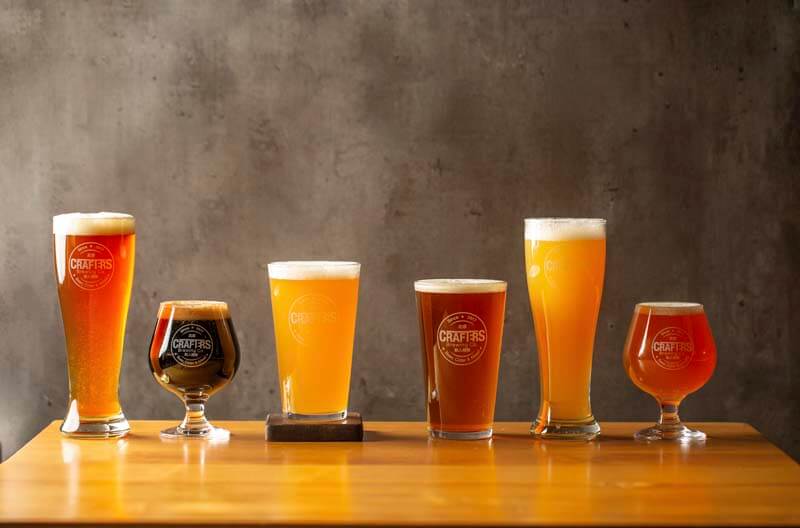
When it comes to serving beer, glassware is important. Just like when a bartender makes an Old Fashioned or Margarita, they pour each respective drink into the right cocktail glass.
And while people in the industry debate the pros and cons of pint glasses, there is no denying that pint glasses are commonly used.
Plus, a pint is a ubiquitous industry measurement, meaning as a brewery, bar, or restaurant owner you should be familiar with this metric. But exactly how much is a pint? And why does the size differ depending on where you are?
Plus, what are the pros and cons of pint glasses? And what might be a good solution to the traditional pint glass?
We’ll break everything down in our guide to pints.
What We’ll Cover in This Piece:
Why Is It Called a Pint?

Photo by Louis Hansel on Unsplash
Often referred to in America as a shaker glass and in the United Kingdom as an imperial or nonic glass, pints actually get their name from an old French word: pinte. Perhaps deriving from the Latin word pincta, which means painted. The thinking here being that the word refers to how these types of glasses often include a marking on the outside to indicate size.
After all, at its core, a pint is just a measurement.
How Much Is a Pint?

Photo by Drew Beamer on Unsplash
A simple question with a couple of different answers depending on where you are in the world.
In the United States, a pint refers to 16 fluid ounces.
Whereas in Britain, a pint means 20 British imperial ounces.
And yes, there is a difference here. The British imperial ounce measurement actually refers to both dry and wet ingredients. On the other hand, in the United States, the fluid ounces measurement refers directly to wet ingredients (while ounces covers dry products).
So, yes this means that an American shaker pint glass is smaller than a British pint.
Here are a few common measurements for reference:
- 1 pint = 473 mLs
- 1 American pint = 16 fl oz
- 1 British or imperial pint = 20 oz
- 1 pint = 10.5 shots (1.5oz each
However, what doesn’t differ is that you’ll find pint glasses used everywhere from pubs in England to bars in America.
A Quick History of the Pint Glass in America

Photo by Adam Jaime on Unsplash
In America, shaker glasses became popular in the early twentieth century as a vessel to make mixed drinks. And they still are today. We’ve all seen the bartender behind the bar using a 16oz glass in conjunction with a cocktail shaker (together both parts equal a Boston shaker) to create a mixed drink.
One only has to look at the name ‘shaker’ to see that these specific glasses were never meant for beer. A bartender would use the shaker pint to literally shake the ingredients together before straining into a proper glass.
In fact, shaker pints weren’t used for beer specifically until after Prohibition. During these post-War years, macro brands like Anheuser-Busch and Coors reigned supreme. Bland, low-alcohol, light lagers didn’t need fancy glasses. Instead, the shaker pint became the perfect utilitarian carrier for these macro beers.
Cheap, durable, and stackable, shaker pints morphed into de facto drinkware in bars across the U.S.
The Three Pros of a Pint Glass

Photo by Louis Hansel on Unsplash
There’s a reason why this ubiquitous glass has become a mainstay for many bars and restaurants and a best-seller on many glassware sites. It’s functional, affordable, and up to the task of continual use in high-volume establishments.
Easy to Store / Easily Stackable
The fairly simple design of a pint glass means that you can stack and store them easily. This creates more space behind the bar for essentials…such as bar equipment, garnish ingredients, napkins, and of course, more alcohol.
There’s a function factor here too. Shaker glasses can be used to serve water, pop, and other beverages—not just beer.
Cheap / Money Saver
Nicer glassware means more expensive glassware. Shaker pints are cheap drinking vessels, typically costing anywhere from $15-$25 a case.
Whereas, higher-end drinkware like a Belgian tulip glass can kick up to closer to $35-$40 a case.
Durable
In a busy bar with bartenders constantly pulling drafts or waiters always carrying drinks to tables, one can imagine that spills and drops happen frequently. Pint glasses are pretty durable, less likely to chip or crack if accidentally mishandled or dropped. In other words, this type of drinkware can withstand the heat of the kitchen, so to speak.
The Three Cons of a Pint Glass

Photography courtesy of Tennessee Brew Works
In today’s modern craft beer industry, the pint glass has developed a bit of a contentious reputation. Mostly, because its design detracts from a peak drinking experience.
Here are three reasons why:
Discourages Head Retention, Detracts Flavor and Aroma
By far and away the biggest con of a pint glass is that it is not the optimal container for presenting beer in its best form. The straight shape discourages the creation of foam at the head of a beer, which brings essential aroma and flavors to a drinker.
Specific glasses are paired with certain beer styles for a reason. There is a science here.
For example, the reason tulip glasses are great for Belgian beers and snifters are perfect for imperial stouts is that their bowl shape brings a beer’s aroma directly to a drinker’s nose and encourages foam retention, enhancing the entire drinking experience.
You don’t get any of that with a pint glass.
Warms Up the Beer Quickly
This is another big sticking point when it comes to using a shaker pint.This straight-sided glass means someone needs to palm the vessel to drink the contents inside. Warm hands will ultimately warm up the beer more quickly.
And will also lead to the beer falling flat at a higher rate.
Encourages Spillage
Although more durable for the front and back of house, a shaker pint actually encourages more spilling from the consumer. A bigger, wider mouth gives one more surface area to accidentally “miss their mouth.”
And from a business perspective, beer on the floor is money out the door.
The Final Word on Pint Glasses: Consider the Nonic Pint

Photography courtesy of Brewers Association
Today, craft beer consumers want to know that they’re drinking the best version of that beer, whether it’s an Allagash White or an Other Half Forever Green. For many, that means drinking out of the proper glassware. There’s even a whole hashtag for it on Instagram, #properglassware, that has almost 600k posts.
But ultimately, it really all comes down to the identity of your establishment. If you’re a high-volume sports bar, then pint glasses might be the best way to go. But if you’re a higher-end craft beer bar, then you should be prepared to invest in proper drinkware that pairs with the beer you’re serving.
One last thought: A nice common ground might be considering a nonic (pronounced “no-nick”) glass. Similar to a pint, but with one big difference, this drinkware includes a characteristic bulge just below the rim. So while these types of glasses can stack like shakers, the node on the side can be used to grip the glass (meaning palms won’t warm the contents inside) and gives a narrower head to encourage that all-important foam retention to lock in flavor and aroma.
Other Content You May Enjoy
To succeed and grow your restaurant, bar, or brewery you need to stand out in local search results. Whether someone is searching for the “best craft beer near me” or “top-rated seafood restaurant in [your city],” Local SEO (Search Engine Optimization) helps your business appear at the top of those search results.
With 81% of consumers using Google Search and Maps to find local businesses, and nearly 90% of customers choosing a business on the first page of search results, optimizing your online presence is essential.
This guide will walk you through Local SEO strategies tailored for restaurants, bars, and breweries, covering Google My Business, website optimization, online reviews, local backlinks, and more.
By the end of this guide, you’ll have a step-by-step action plan to increase your search rankings, attract more local customers, and grow your business.
In today’s digital world, having a well-designed, functional website is essential for restaurants, bars, and breweries. It goes beyond having social media. A great website can help attract new customers, showcase menus, accept reservations, and even drive online sales. But one of the most common questions business owners ask is: How much should a website cost in 2025?
The answer depends on several factors, including the type of website, features, complexity, and whether you choose a DIY solution or hire a professional web developer. Costs can range from a few hundred dollars for a basic website to tens of thousands for a fully customized, feature-rich platform.
This guide will break down website costs for restaurants, bars, and breweries, helping you understand the pricing landscape and choose the best solution for your business
Trivia nights have become an incredible marketing strategy for bars, restaurants, and breweries to draw in crowds and engage with new customers. With the recent collaboration between Geeks Who Drink, Timeplay, and the iconic television show Jeopardy!, businesses now have an exciting opportunity to host the Jeopardy! Bar League. This partnership combines the global brand recognition of Jeopardy! with Timeplay’s cutting-edge technology and the fun of live trivia from the experts at Geeks Who Drink.
In this piece we’ll cover what this new collaboration between these two trivia powerhouses is and how you can bring this unique experience to your venue.
In today’s world, both websites and social media platforms are crucial for a brewery, bar, or restaurant’s online presence. However, consumer habits show distinct preferences for each, depending on the context of their search or interaction.
In this guide, we’ll go over the basics, walk you through how to leverage these tools effectively, and show you how understanding these trends can help your venue better meet your customers’ expectations.
As a restaurant, bar, brewery, or any venue with a food and beverage program, having a modern, functional, and aesthetically pleasing website isn’t just a luxury—it’s a necessity.
No matter the size of your business, your new potential customers often interact with your website first—and first impressions matter.
In this piece, we’ll explore the top website trends shaping the online presence of hospitality businesses in 2025. These trends will help your venue stand out and attract more customers while creating a unique and modern experience to establish the perfect guest experience from start to finish.
For bar owners, hospitality managers, and small business owners, selecting the right gin brands is more than just filling the shelves—it’s about curating a distinctive customer experience. Gin has soared in popularity, becoming a staple of modern cocktail culture. With its complex botanical infusions, gin offers versatile, memorable flavors that can attract a wide range of customers. But with so many choices available, which brands should you prioritize to bring out the best in your gin menu?
This guide explores the seven best gin brands that have proven themselves through quality, craftsmanship, and unique flavor profiles. By understanding what makes each brand special, you and your staff will be better equipped to create a standout gin selection that delights your patrons, reinforces your brand’s reputation with a robust gin drinks menu, and helps you continue crafting classic and innovative gin cocktails.

